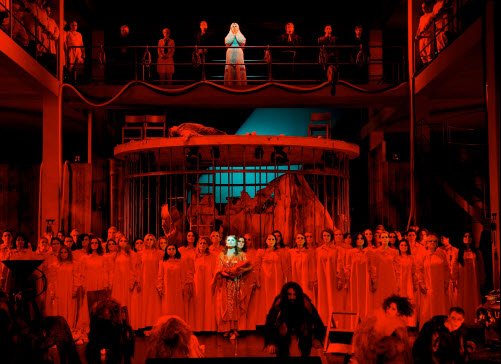 Facebook
Facebook
 X
X
 Instagram
Instagram
 TikTok
TikTok
 Youtube
Youtube

We've got more from Dr. Nicolas Reveles regarding the Bayreuth Festival. See part one of this interview here.
Nic Reveles: The Tannhauser was probably the weirdest thing I have ever seen in my life. It was very strange. All four of the productions I saw were what we would call regietheater. They don’t do anything traditional at Bayreuth anymore and throughout Europe and Germany it’s very much a director-driven industry right now, but the Tannhauser was very, very, odd.
For example, Venus was pregnant...
SDR: Okay — she was pregnant with love?
NR: No, she was pregnant with baby. She was pregnant all through the show. You may be aware that Venus does not appear in Act II. Well, she was in Act II entering as one of the guests in the famous “entrance of the guests” scene. She then danced the waltz with Tannhauser.
She then reappeared in Act III, which she does, usually singing offstage or behind a scrim because it’s her voice kind of calling Tannhauser back. However, she came right on stage, pregnant just as much as she was in Act I. Instead of a flowering staff for Tannhauser, showing that he’s been redeemed, Venus gives birth to the baby.
So here’s the tableaux for the end of Tannhauser — the chorus is dressed in deep red polyester choir robes that you would typically see in a Protestant church here in America. Venus is in front of them with her baby in swaddling clothes and Elizabeth is way up in the rafters being — Saint Elizabeth. Tannhauser dies and that’s the end.
Then there are these extraneous characters [throughout the production] in the Venusberg scene, for instance, there are these sea creatures that appear during the bacchanal that look like manta rays, but with decidedly phallic features. Very, very odd and they’re dancing around up there but there’s no choreography. There are no dancers in the Venusberg scene.
At the conclusion of the opera there are these monkey creatures that appear and are jumping up and down during the final chorus and the birth of Venus’ child. After the final chord, and you’re hoping for that wonderful resonant sound, you hear another sound and that is the jumping up and down of these four monkey creatures. So the end, musically, is sort of ruined by a director who doesn’t understand that musically, we want the piece to finish with the music not with some extraneous sound from stage monkeys.
So the Tannhauser was odd.
SDR: It sounds like the symbolism made some sense — Venus being pregnant and Tannhauser being redeemed through a new life...
NR: Yes, yes, I saw where the director was going with that but it just didn’t work. At all.


We've got more from Dr. Nicolas Reveles regarding the Bayreuth Festival. See part one of this interview here.
Nic Reveles: The Tannhauser was probably the weirdest thing I have ever seen in my life. It was very strange. All four of the productions I saw were what we would call regietheater. They don’t do anything traditional at Bayreuth anymore and throughout Europe and Germany it’s very much a director-driven industry right now, but the Tannhauser was very, very, odd.
For example, Venus was pregnant...
SDR: Okay — she was pregnant with love?
NR: No, she was pregnant with baby. She was pregnant all through the show. You may be aware that Venus does not appear in Act II. Well, she was in Act II entering as one of the guests in the famous “entrance of the guests” scene. She then danced the waltz with Tannhauser.
She then reappeared in Act III, which she does, usually singing offstage or behind a scrim because it’s her voice kind of calling Tannhauser back. However, she came right on stage, pregnant just as much as she was in Act I. Instead of a flowering staff for Tannhauser, showing that he’s been redeemed, Venus gives birth to the baby.
So here’s the tableaux for the end of Tannhauser — the chorus is dressed in deep red polyester choir robes that you would typically see in a Protestant church here in America. Venus is in front of them with her baby in swaddling clothes and Elizabeth is way up in the rafters being — Saint Elizabeth. Tannhauser dies and that’s the end.
Then there are these extraneous characters [throughout the production] in the Venusberg scene, for instance, there are these sea creatures that appear during the bacchanal that look like manta rays, but with decidedly phallic features. Very, very odd and they’re dancing around up there but there’s no choreography. There are no dancers in the Venusberg scene.
At the conclusion of the opera there are these monkey creatures that appear and are jumping up and down during the final chorus and the birth of Venus’ child. After the final chord, and you’re hoping for that wonderful resonant sound, you hear another sound and that is the jumping up and down of these four monkey creatures. So the end, musically, is sort of ruined by a director who doesn’t understand that musically, we want the piece to finish with the music not with some extraneous sound from stage monkeys.
So the Tannhauser was odd.
SDR: It sounds like the symbolism made some sense — Venus being pregnant and Tannhauser being redeemed through a new life...
NR: Yes, yes, I saw where the director was going with that but it just didn’t work. At all.
Comments